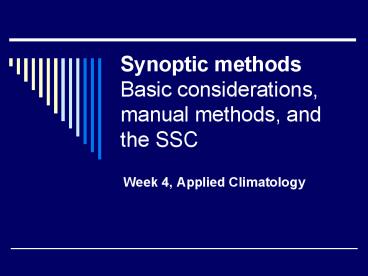Synoptic methods Basic considerations, manual methods, and the SSC - PowerPoint PPT Presentation
1 / 30
Title:
Synoptic methods Basic considerations, manual methods, and the SSC
Description:
Synoptic climatology relates the atmospheric circulation ... McCabe and Muller (2002) Muller classification (1977) Grosswetterlagen. Hess and Brezowsky (1952) ... – PowerPoint PPT presentation
Number of Views:46
Avg rating:3.0/5.0
Title: Synoptic methods Basic considerations, manual methods, and the SSC
1
Synoptic methodsBasic considerations, manual
methods, and the SSC
- Week 4, Applied Climatology
2
Yarnal (1993)
- Synoptic climatology relates the atmospheric
circulation to the surface environment. - (Surface environment is defined as the planetary
boundary layer) - Definitions of synoptic simultaneous or holistic
3
Two classification subdivisions
- Environment-to-circulation
- Circulation-to-environment
- Empirical
- Modeling
4
Terms that we see
- Weather types
- Circulation patterns
- Air masses
5
Method categorizations
- Manual vs. automated
- Subjective vs. objective
- Hybrid
6
Assumptions of synoptic work (from Yarnal 1993)
- The atmospheric circulation is a critical
determinant of the surface environment - The Bergen school model of the mid-latitude
cyclone is correct - The atmospheric circulation can be partitioned
into discrete intervals
7
Assumptions of synoptic work (from Yarnal 1993)
- The classification identifies all important map
patterns or weather types - Corollary the lumper vs. the splitter
- That the method do what you think it does
- Temporal scales of the atmospheric circulation
and environmental phenomenon match
8
Assumptions of synoptic work (from Yarnal 1993)
- The grid scale can adequately represent the
region of interest - Within-group variability is not a problem
9
Categorization of approaches
- Can also add global scale
- What are the benefits/drawbacks of
different-sized domains?
10
What is analyzed?
- A set of variables over time?
- A set of stations over time?
- A set of variables across stations?
11
P-mode
- A set of variables over time (usually for one
station)
12
S-mode
- A set of stations over time (one variable only)
13
R-mode
- A set of variables over stations
14
Compositing
- Always environment to circulation
15
Indexing
16
Some historic manual weather classifications
17
Lamb weather types (1972)
SCALE? ASSUMPTIONS?
18
Lamb weather types
Climate Research Unit, UEA
19
Muller classification (1977)
McCabe and Muller (2002)
20
Muller classification (1977)
21
GrosswetterlagenHess and Brezowsky (1952)
James (2007)
22
Grosswetterlagen
- Issue of scale?
- Lumper or splitter?
23
Hybrid classification schemes
- Manual identification
- Later, automated classification done from
original rules
24
Schwartz (1991)
- Weather types developed for North Central US from
examining 850 mb T and Td - Each day at each station classified into a group
based on rules
25
SSC (1996 2000)
- DP (dry polar)
- DM (dry moderate)
- DT (dry tropical)
- MP (moist polar)
- MM (moist moderate)
- MT (moist tropical)
- TR (transitional)
26
SSC
- Classifies each day at a location based on the
following parameters - Temperature (4am, 10am, 4pm, 10pm EST)
- Dew point depression (same times)
- Temperature and dew point range
- Mean sea level pressure
- Mean cloud cover
- Pressure change
- Wind change
27
SSC
- Criteria vary by time of year and location
28
Wilmington, 29th March 2000
- Dry Moderate (DM) is lowest (5 pts)
29
SSC mapping
30
SSC mapping
- How is this different?































